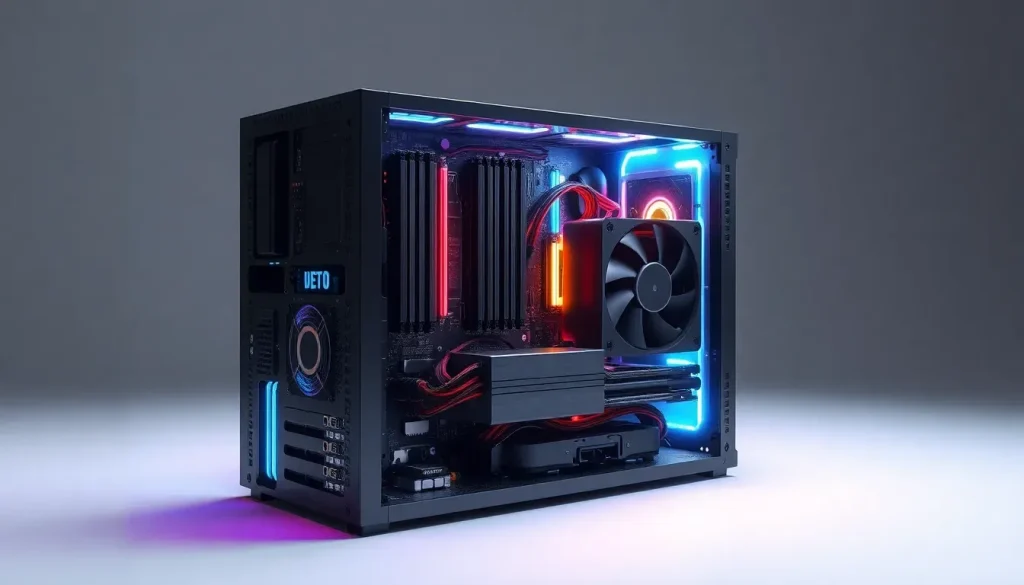BTF 3.0 Hides PC Cables by Slotting PSU into Motherboard

As the world of PC building continues to evolve, enthusiasts are constantly seeking innovative solutions to enhance performance and aesthetics. One of laster advancements that has gained significant attention is the BTF 3.0 motherboard design, which aims to minimize the cable clutter that often plagues traditional builds. This new evolution not only promises a cleaner look but also introduces a unique approach to power delivery that challenges conventional methods.
In this article, we will explore the intricacies of the BTF 3.0 design, its compatibility with existing hardware, and its potential impact on the future of PC building. From the innovative back-plug motherboard concept to its implications for DIY enthusiasts, we’ll cover everything you need to know about this cutting-edge technology.
Understanding BTF motherboard design
The BTF motherboard design, which stands for Back To The Future, revolutionizes the way power and data connectivity are managed within a PC. Unlike traditional motherboards that prominently feature connectors on the front, the BTF design relocates all connectors to the back. This not only enhances the visual appeal of a build but also simplifies cable management significantly.
This innovative design concept allows for a more streamlined assembly process, as users no longer have to navigate a maze of cables when constructing their systems. By centralizing connections at the back, BTF motherboards offer a cleaner and more organized look, which is especially appealing for aesthetic-focused builds.
- Enhanced Aesthetics: A cleaner look without visible cables.
- Simplified Assembly: Easier to connect components with centralized connections.
- Improved Airflow: Reduced cable clutter allows for better airflow within the case.
Key features of BTF ASUS motherboards
ASUS has embraced the BTF design with a range of motherboards that exemplify the technology's potential. These motherboards come equipped with features that prioritize both performance and user experience.
One of the standout features is the direct power connection for GPUs through dedicated slots, which eliminates the need for bulky power cables. This is complemented by a reinforced PCB, capable of handling significant power loads, ensuring stability even during demanding operations.
- Direct GPU Power Slots: Streamlined power delivery to graphics cards.
- Reinforced PCB: Enhanced durability and performance under load.
- USB-integrated Fans: Simplified cooling solutions with minimal cable requirements.
Building a PC with ASUS BTF components
Creating a system using ASUS BTF components is a streamlined process. The BTF design caters to both seasoned builders and newcomers alike. Here’s a quick guide on how to get started:
- Select a BTF-compatible motherboard from ASUS.
- Choose components that support the BTF architecture, such as GPUs with dedicated slots.
- Assemble the system with minimal cables, utilizing pre-routed solutions for fans and I/O.
- Connect the PSU directly to the motherboard using the large BTF slot.
- Power on the system and enjoy a clean, efficient setup.
By following these steps, users can achieve a professional-looking build with significantly reduced cable clutter, enhancing both performance and aesthetics.
ASUS BTF 5090: A Case Study
The ASUS BTF 5090 motherboard showcases the potential of the BTF design in practical application. This motherboard not only incorporates the back-plug design but also features advanced power management capabilities.
With a power rating of up to 2,145W, the BTF 5090 is engineered to support high-performance CPUs and GPUs. This capability is achieved by distributing power through the motherboard, a method that requires careful design and construction to ensure reliability.
- High Power Rating: Supports demanding components.
- Innovative Power Distribution: All power flows through the motherboard.
- Customizable User Experience: Options for fan control and RGB lighting integration.
Compatibility with existing hardware
One of the main concerns for enthusiasts considering the BTF 3.0 system is compatibility with legacy hardware. The good news is that BTF 3.0 maintains compatibility with previous generation hardware, provided that both the PSU and motherboard are equipped with the necessary BTF features.
For users with existing setups, the introduction of adapters could facilitate the use of older components with the new technology. However, this approach may compromise the aesthetic ideals of the BTF concept, which emphasizes a clean and cable-free environment.
Here are some important points to consider:
- Adapters Available: Some brands may provide adapters for legacy hardware.
- New Systems Recommended: Best suited for fresh builds to fully utilize BTF features.
- Future Updates: Anticipate ongoing support and compatibility enhancements.
The future of BTF technology
Looking ahead, the BTF concept is poised for continued evolution. Future iterations may focus on improving fan power connections and front I/O systems. Innovations like pogo pins could replace traditional connectors, promoting an even more streamlined build process.
The aspiration is to standardize these connections, removing the need for cumbersome cables entirely. Such changes would require precise manufacturing tolerances, but the potential benefits for aesthetics and functionality are significant.
Cable management solutions and community engagement
The BTF 3.0 design aligns with a growing demand for efficient cable management solutions among PC builders. Community feedback has emphasized the importance of aesthetics in modern builds, pushing manufacturers to innovate accordingly.
With platforms like YouTube showcasing various builds and cable management techniques, enthusiasts can find inspiration and guidance in creating their ideal setups. For instance, the video titled "NO MORE Messy Cables with ASUS Hidden Connector" illustrates practical examples of how the BTF design can transform a PC build.
As the BTF concept gains traction, it will undoubtedly shape the future of PC building, promoting cleaner, more efficient systems that cater to both performance and aesthetic demands.




Leave a Reply